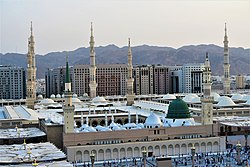Islamic architecture
Islamic architecture is a type of architecture. It has been used for many different kinds of buildings; many mosques were built based on old Egyptian style. It can be very varied. Decoration is often limited to calligraphy, as Muslims are forbidden to make images of god. They also make complicated tile artwork and decorate buildings, pottery and canvas with painted calligraphy looking beautiful.
Gallery
The interior side view of the main dome of Selimiye Mosque in Edirne
Arabic Calligraphy on large pishtaq of the Taj Mahal
the Shah Mosque in Isfahan, Iran
The interior view of the Mezquita
Islamic Architecture Media
The Mosque of the Prophet, standing on the site of Muhammad's first mosque in Medina. The present-day building is the result of many reconstructions and expansions up to modern times.
The Umayyad-era Mshatta Facade, from a palace near Amman, now in the Pergamon Museum in Berlin. The decoration displays Byzantine and Sasanian influences.
Great Mosque of Damascus (early 8th century)
The Dome of the Rock in Jerusalem (late 7th century, with later renovations)
Interior of the al-Ukhaidir Palace (c. 775) in Iraq, one of the earliest surviving examples of Abbasid architecture
Panel of stucco decoration from Abbasid Samarra (9th century), Iraq, exemplifying the "beveled" style that employed more abstract motifs.
The walls and minaret of the Great Mosque of Samarra built by the Abbasids in the 9th century
The mihrab and maqsura area of the Great Mosque of Córdoba, added to the mosque by al-Hakam II (late 10th century)
The Samanid Mausoleum in Bukhara (10th century), built entirely of brick, is one of the oldest monumental tombs in the Islamic world.
Bab al-Futuh in Cairo, one of the gates built by the Fatimid vizier Badr al-Jamali (11th century)













